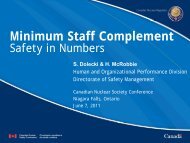Investigation of the Environmental Fate of Tritium in the Atmosphere
Investigation of the Environmental Fate of Tritium in the Atmosphere
Investigation of the Environmental Fate of Tritium in the Atmosphere
Create successful ePaper yourself
Turn your PDF publications into a flip-book with our unique Google optimized e-Paper software.
INVESTIGATION OF THE ENVIRONMENTAL FATE OF TRITIUM IN THE ATMOSPHERE<br />
Figure 2.5: Depiction <strong>of</strong> <strong>the</strong> Process <strong>of</strong> Ternary Fission <strong>of</strong> 235 U <strong>in</strong> Reactor Fuel<br />
(from Sültenfuß, 2008).<br />
fission<br />
235 U Kr + Ba + 2 n<br />
6 Li 2<br />
H<br />
fission <strong>of</strong> 6 Li<br />
2.4.2.2 Boil<strong>in</strong>g Water Reactors (BWRs)<br />
14 N<br />
3 H + 2 H + 4 He + Heat <strong>of</strong> U-fission<br />
Fusion<br />
5 He + Energy<br />
4 He + n<br />
12 C + 3 H<br />
<strong>Tritium</strong> <strong>in</strong> Boil<strong>in</strong>g Water Reactors (BWRs) is primarily produced from burnable poison,<br />
ternary fission, and deuterium activation. <strong>Tritium</strong> is produced <strong>in</strong> BWRs by ternary fission <strong>in</strong><br />
<strong>the</strong> fuel at approximately <strong>the</strong> same rate as <strong>in</strong> PWRs (i.e., at a rate <strong>of</strong> 6 to 9 x 10 11 Bq tritium<br />
per MW(e)a). In addition, tritium can be generated by neutron activation <strong>in</strong> both <strong>the</strong> coolant<br />
and <strong>in</strong> <strong>the</strong> control rods (UN, ILO and WHO, 1983). For example, tritium is generated <strong>in</strong> <strong>the</strong><br />
coolant <strong>of</strong> BWRs by activation <strong>of</strong> deuterium at a rate <strong>of</strong> about 4 x 10 8 Bq per MW(e)a, as<br />
described by <strong>the</strong> follow<strong>in</strong>g equation:<br />
2 1 3<br />
1H + 0n → 1 H Equation 2.6<br />
In terms <strong>of</strong> tritium production by neutron activation <strong>in</strong> <strong>the</strong> control rods, prior to 1971, boron<br />
carbide control rods were used <strong>in</strong> BWRs, yield<strong>in</strong>g approximately 3 x 10 11 Bq tritium per<br />
MW(e)a (Smith and Gilbert, 1973), although tritium has not been shown to diffuse through<br />
<strong>the</strong> boron carbide matrix (Trevorrow et al., 1974). As for PWRs, current BWRs use<br />
zirconium alloy cladd<strong>in</strong>g, which limits <strong>the</strong> tritium release <strong>in</strong>to <strong>the</strong> coolant to less than<br />
7 x 10 9 Bq per MW(e)a.<br />
BACK TO TABLE OF CONTENTS 16



